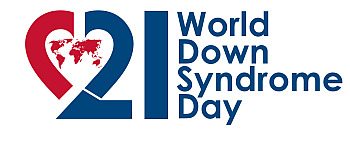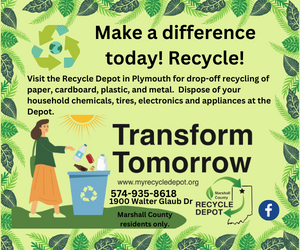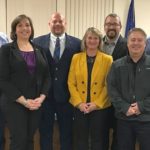 People around the globe will be supporting the 10th World Down Syndrome Day on March 21. The originators of the annual event hoped to raise awareness, acceptance and inclusion of people with Down syndrome. The date of March 21 (3/21) was chosen to symbolize how Down syndrome occurs. The body works by information contained in each cell in a form called DNA. Each cell of the body typically has strips organized into 23 pairs. People with Down syndrome have 3 copies (one “extra”) of the 21st.
People around the globe will be supporting the 10th World Down Syndrome Day on March 21. The originators of the annual event hoped to raise awareness, acceptance and inclusion of people with Down syndrome. The date of March 21 (3/21) was chosen to symbolize how Down syndrome occurs. The body works by information contained in each cell in a form called DNA. Each cell of the body typically has strips organized into 23 pairs. People with Down syndrome have 3 copies (one “extra”) of the 21st.
Locally, parents of children with Down syndrome continue to share information on how they are encouraging their children to become the best that they can be.
 Keel Allen, son of Don and Sandi Allen, sounds like a typical three-year-old. Sandi said, “Keel’s personality is loving, affectionate, helpful and happy. But he is like any other child. He can also be stubborn, strong willed, manipulative, and just plain ornery.” According to Sandi, children with Down syndrome will do most of the things that other children will do, but it will just take then a little longer to do them.
Keel Allen, son of Don and Sandi Allen, sounds like a typical three-year-old. Sandi said, “Keel’s personality is loving, affectionate, helpful and happy. But he is like any other child. He can also be stubborn, strong willed, manipulative, and just plain ornery.” According to Sandi, children with Down syndrome will do most of the things that other children will do, but it will just take then a little longer to do them.
Children with Down syndrome have a wide variation in mental abilities, behavior and physical development. Sandi said, “Each individual has his/her own unique personality, capabilities and talents. In other words, people with Down syndrome are not all the same; just like individuals in the typical population are not all the same.”
Keel , who will soon turn four, is enrolled in the preschool program at Jefferson Elementary School in Plymouth. Sandi said they have been talking primarily to other parents and Keel’s teachers to try to determine where to place him next year. “It is a decision that is not easily made.” Sandi said.
Fortunately, Keel has not experienced many of the health problems that children with Down syndrome often have. He did have surgery on his tonsils, adenoids and to insert tubes in his ears to help with his sleep apnea and hearing issues.
Keel and his siblings Rourke (5) and Piper (2) are enjoying being a close knit family. Sandi said, “What we most want everyone to know is that we love him so much and that he shows us every single day how much he loves us. What’s more important than that?” She added, “He has the potential to go to college, get a job, fall in love, get married, and live a long healthy life. Maybe none of those things will happen for him, but hopefully the future will be bright.”
Paul and Marla Murasko are speaking out to others about the strides that their son, Jacob, has made even though he started out life with the health problems of many Down syndrome children. Jacob, who will be nine on March 22, had a Blalock-Taussig shunt put in at 16 days old. Marla said, “It was a major surgery for him since he was already fragile.” The procedure involved doctors going through the tiny baby’s ribs to do the operation necessary to help him get stronger for his open heart surgery. At six months, Jacob had open-heart surgery to repair his Tetralogy of Fallot and AV canal diagnosis. Additionally, Jacob also has hyperthyroidism, thyroid issues that are usually common in most children with Down syndrome. Marla said, “However, despite the typical therapies including physical, occupational and speech therapy are school along with music therapy at home, Jacob is a healthy, thriving boy who participates in school, is very active in sports and a contributing member in our community.” “I truly believe that Jacob has brought out a lot of good in people. I also believe that he has a lasting impression on others and has left his mark on our community.” Marla said.
Both Paul and Marla are especially glad that Jacob has made friends in his second grade call at Menominee Elementary, Plymouth. In October 2014, Marla helped Jacob talk to his classmates about his condition using a slide show. Marla said, “It allowed them to get a better understanding of Jacob and his diagnosis.” “He has established an amazing group of friends, who are truly his “class helpers”, they respect him, care for him and support him throughout his day.” she said. Marla said “It’s amazing what inclusion does not only for the child with special needs, but what it gives to other children.” Inclusion where children with special needs attend the majority of the day in a regular classroom. Marla said, “It allows these young minds to learn about empathy and respect for others’ differences. Inclusion helps foster friendships that would have not formed if typically developing peers were not introduced to children with differences in a school setting.”
Jacob also had an opportunity to speak to in front of over a 100 people at his Cub Scout ceremony last month..
Jacob’s reading is getting better and better each week. He uses a reading system called Edmark Reading Program. The program uses a site word approach to teach emergent reading skills. However, Marla says they will always have to advocate for Jacob. She said, “I don’t see that battle ever ending. There will always be some kind of “fork” in the road preventing Jacob from receiving the same education, resources or activities that his typical peers are receiving , among other things, Marla contributes to her ongoing blog about children with disabilties. “It’s our job as his parents to show others that through a different approach, he can achieve the same things academically, functionally and socially that his peers are doing, just maybe at a different level or in a different framework.” Marla said, “I started my blog to share our everyday life as a typical family with “special circumstances” .Jacob is spreading awareness and as his mother, I am giving him the voice to do that through my blog.”
The Murasko”s are hoping that others will not stereotype children with Down syndrome. Marla said, “Each child is unique, and have different characteristics that are different from each other.” “Keep in mind that children with Down syndrome have a strong ability to learn, it just may take them longer that their peers.”
The Allen’s and Muraskos are grateful for the support of their families and the friends they have met. Sandi Allen said, “One of the biggest blessings that Keel has brought to us is the opportunity to meet other families with special needs family members/friends.” She said they look to the Michiana Down syndrome support group where they have learned of news on research, opportunities for social gatherings, and medical advice.
In the 1920s, the life expectancy for people with Down syndrome was about nine years; in 1983, it was 25 years; and today it is about 60 years. Down syndrome is the most common genetic condition. In the United States there are approximately 400,000 individuals with Down syndrome.
Carol Anders Correspondent













